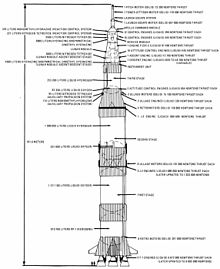

This article does not cite any sources. Please help improve this articlebyadding citations to reliable sources. Unsourced material may be challenged and removed.
Find sources: "Ullage motor" – news · newspapers · books · scholar · JSTOR (June 2008) (Learn how and when to remove this message) |
Ullage motors (also known as ullage enginesor ullage rockets) are relatively small, independently-fueled rocket engines that may be fired to accelerate the rocket prior to main engine ignition, when the vehicle is in a zero-g situation.

Cryogenic-liquid-fueled rockets keep their propellants in insulated tanks. These tanks are never completely filled to allow for expansion. In micro-gravity conditions the cryogenic liquids are without a free surface existing in a slushy state between solid, liquid, and gas. In this mixed state, ullage gases may be sucked into the engines, which is undesirable. Small rocket engines, called "ullage motors", are sometimes used to settle the propellant prior to the main engine ignition to allow the formation of a temporary free surface (with a distinct boundary between liquid and gas states). These motors provide acceleration that moves the main engine liquid propellants to the bottom of their tanks ("bottom" in this usage always meaning relative to the alignment of the main motor the ullage motors are serving), so they can be pumped into the engine plumbing. Meanwhile the ullage gas floats to the top, away from the engine inlets. Such motors were first invented by Soviet engineers for the Molniya interplanetary launch vehicle in 1960.
The firing of the ullage motors is used during stage separation of rocket and/or stabilization of a rocket when there are brief reductions in acceleration which could allow the liquid propellant to float away from the engine intakes. Ullage motors are also commonly employed on deep-space missions where a liquid rocket needs to start a burn after traveling in micro-gravity.
Ullage motors are typically very small; research[who?] shows that accelerations of the order 
The four ullage motors of the Saturn V rocket used in the American Apollo program were located on the second stage. In the third stage (known as S-IVB), there was a more general Auxiliary Propulsion System that also had ullage functions. Ullage is often a secondary function of the reaction control system such as on the Apollo Lunar Excursion Module (LEM). Jim Lovell in his book "Lost Moon" recounted a description of a course-correction burn of the LEM's main descent engine to re-enter a free return trajectory to Earth during the ill-fated Apollo 13 mission:
When the ship had stabilized in the proper attitude for firing, Lovell would deploy the LEM's landing gear, extending its four spidery legs to get them out of the way of the descent engine. Next the computer, relying on other instructions Haise typed into it, would fire four of Aquarius's attitude jets for 7.5 seconds. This procedure, known as ullage, was intended to jolt the spacecraft slightly forward and force the descent engine fuel to the bottom of its tanks, eliminating bubbles and air pockets. After that, the main descent engine would ignite automatically firing at 10 percent thrust for 5 seconds.[1]